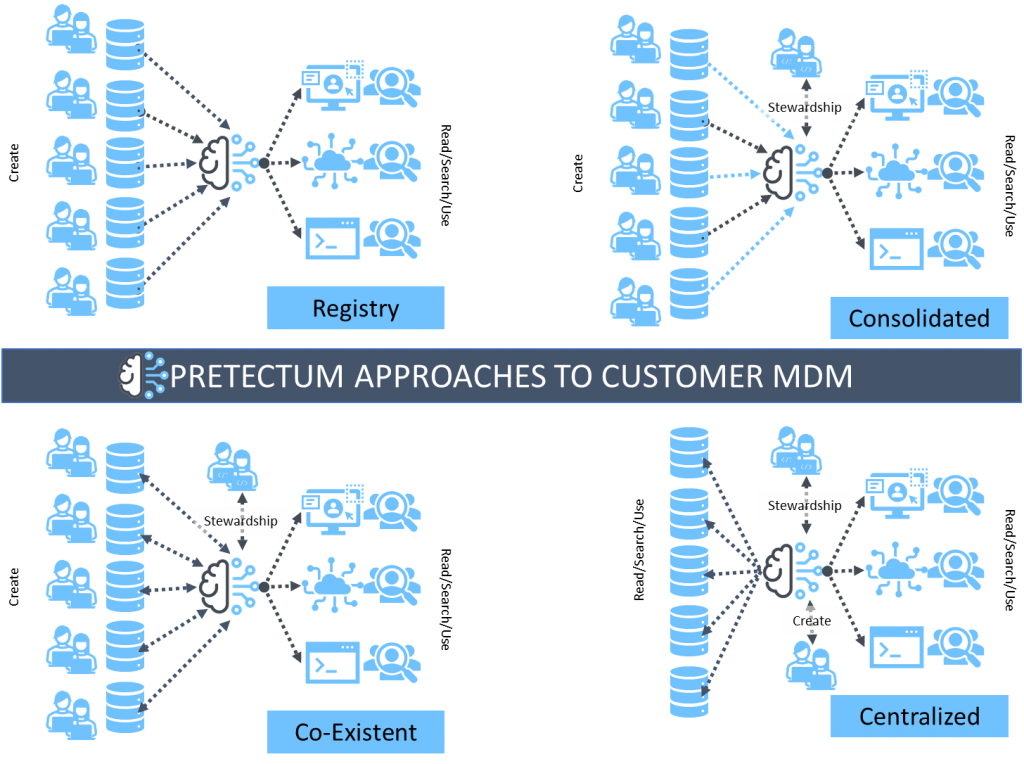No single CMDM strategy fits every need.
The advantage of customer master data management is that its practice can be flexible. A customizable approach to managing and governing your customer master data repository is quite typical. That said, there are four general architectures into which initial CMDM designs fall.
What the foundation of your Customer Master Data Management (CMDM) system is built on will depend on the implementation style you agree gives you the best chance of project success. The architecture you choose will largely be determined by your business situation when it comes to data management. The different implementation styles you can choose from have main differences being whether you control your data from a central hub or synchronize the hub with your existing data sources.
But why is it essential to give careful consideration to the style of implementation?
Maintaining a single version of the truth across your organization is a high priority for most organizations – together with meeting compliance and regulatory obligations. Focus is placed on improving data quality, establishing guidelines for data governance, and ensuring data can be easily managed and accessed across the business.
Each of these factors can be achieved by using the most common implementation styles. However, Customer Master Data Management systems vary widely between organizations, and your type of deployment will depend on your core business, corporate structure, and company goals.
Pretectum can advise you on the best approach depending on your business needs.
Let’s take a look at the four common Customer Master Data Management implementation styles to help you decide which one most closely matches your organizational requirements.
Registry Style CMDM
In this approach, CMDM works with abbreviated records, or “stubs,” that detail the data’s source, current location, and more. Registry is the fastest and least expensive architecture to deploy because it minimizes the amount of data moving through CMDM tools, instead, it consolidates stubs into a working repository.
The disadvantages of registry include higher latency inherent in gathering and comparing master records with remote device information. Additionally, registry is often just a one-way collection, and changes made at the master level in all likelihood do not propagate to remote sources, resulting in periodic inconsistencies between master and remote.
Registry style, is mainly used to spot duplicates by running cleansing and matching algorithms on data from your various source systems. It assigns unique global identifiers to matched records to help identify a single version of the truth.
Cleansed and matched records receive identifying cross-referenced information and this assumes the source system can manage the quality of its data. Pretectum CMDM supports the Registry style approach.
Information needed to match and provide the link between corresponding records is stored centrally, and a view of this data can be accessed as required. One concern with this approach might be data proliferation.
When a single, comprehensive view of a customer is needed, the registry uses each reference system to build the 360-degree view in real time. However, central governance of the data is required to ensure the golden record is reliable.
If you have a large number of source systems spread across the world, it can be difficult to establish an authoritative source. A Registry-style approach can be used to analyze the data while avoiding the risk of overwriting information in the source systems. This will help you avoid potential compliance failure or other regulatory repercussions (which may vary from country to country) that could occur if source data is changed.
Registry Style provides a read-only view of data without modifying master data and is a useful way to remove duplications and gain consistent access to your master data.
It offers low-cost, rapid data integration with the benefit of minimal intrusion into your application systems.

Consolidated Style CMDM
A consolidated architecture is similar to a registry but moves data from sources to the master repository. This approach is popular in environments where latency is expected, and consolidation generally takes place during scheduled batch process windows. However, as with the registry style, data in the master repository is not synchronized with downstream sources.
Looking at the Consolidated style, the master data is generally consolidated from multiple sources in the hub to create a single version of the truth, otherwise known as the golden record.
A golden record is stored in the central hub and used for reporting and reference. However, any updates made to the master data are then applied to the originating sources.
With a Consolidated style, you can pull master data from several existing systems and channel it into a single managed CMDM hub. This data can then be cleansed, matched, and integrated to offer a complete single record for one or more master data domains.
Consolidated hubs are inexpensive and quick to set up, providing a fast and efficient way to facilitate enterprise-wide reporting. This style is mainly used for analysis, giving you a trusted source of data for reporting and analytics. Pretectum supports the consolidated style of customer MDM.

Co-existent Style CMDM
This architectural approach takes consolidated CMDM a step further and adds the critical step of synchronizing master data back down to the sources, creating a master record that ‘coexists’ in both the prime repository and at the individual system level.
This is a more complex approach and also comes with high latency, as data needs to be collected and disseminated back downstream via separate batch processes. This architecture is common with small and mid-sized companies that can afford to synchronize master data multiple times per defined period.
A Co-existent style allows you to construct a golden record in the same way as the Consolidation style, but your master data is stored in the central CMDM system and updated in its source systems.
The Co-existent style can be more expensive to deploy than the Consolidated style as master data changes can happen in the CMDM system as well as in the application systems.
All attributes of the master data model must be consistent and cleansed before uploading them into the Customer Master Data Management system.
The main benefit of this style is that data is mastered in source systems and then synchronized with the hub, so data can co-exist harmoniously and still offer a single version of the truth.
Another benefit of this approach is that the quality of master data is improved, and access is faster. Reporting is also easier as all master data attributes are in a single place.
A Consolidated hub can naturally evolve into a Co-existent Style hub if your business decides it requires the advantage of being able to link centrally governed data back to the source systems. Pretectum supports the Co-Existent Style of MDM implementation.

Centralized CMDM
The most controlling command and control architectural approach, centralized style CMDM, is also the most costly in terms of overhead.
Master data is originated in a master repository, where it is created in a clean standardized way, and then offered to the sources.
This style can introduce latency because of the central coordination between master and beneficiary systems but it comes with the advantage of enforcing data governance rules across the enterprise.
Centralized MDM requires a high level of expertise and the right level of organizational commitment to ensure proper flow and prevent flawed data from propagating across the environment.
The Centralized style stores and maintains master data attributes using linking, cleansing, matching, and enriching algorithms to enhance the data. The enhanced data can then be syndicated to other systems.
It’s not uncommon for organizations to begin with one CMDM architecture and then evolve into another. The measure of a successful CMDM build is the efficiency, speed, and consistency with which master data is moved and stored.

